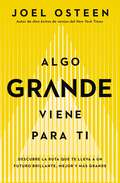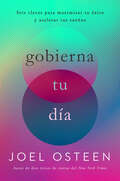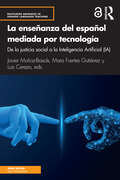- Table View
- List View
Algo grande viene para ti: Descubre la ruta que te lleva a un futuro brillante, mejor y más grande
by Joel OsteenCOMIENZA A CREER DE NUEVO, COMIENZA A SOÑAR DE NUEVO,COMIENZA A HACER PLANES DE LO QUE ESTÁ EN TU CORAZÓN. Ya sea que estés escalando hacia el siguiente nivel, esforzándote por llegar a una meta fuera de tu alcance o haciendo todo lo posible para superar un desafío, es hora de que logres una vida mejor y grandes cosas. Cuando te esfuerzas por cumplir con tus expectativas, ¡recuerda que donde estás ahora no es donde debieras estar! En Algo grande viene para ti, el autor número uno en ventas del New York Times, Joel Osteen, desafía tu percepción sobre tu situación actual y te inspira a perseverar para lograr lo mejor que se avecina. Sea lo que sea que estés experimentando, no pierdas la fe, ni renuncies a tus sueños. Espera lo mejor. Porque algo grande está por llegar: mayor alegría, mayor fuerza, mejores relaciones, mejores oportunidades, mayor éxito y mayor paz. Todo esto te pertenece. Lo que sea que hayas estado esperando, trabajando, orando y proclamando, está en camino. Algo grande viene para ti nutrirá tu alma y empoderará tu corazón para superar el dolor y dominar lo banal. Tu historia está lejos de terminar y lo mejor está por venir. No te rindas justo cuando estás a punto de descubrir un nuevo nivel de aumento, paz y gozo. Vislumbra tu gran avance justo adelante y aguanta un poco más: ¡lo mejor está por llegar!
Gobierna tu día: Seis claves para maximizar tu éxito y acelerar tus sueños
by Joel Osteen¡Gobierna tu día o tu día te gobernará!Seguramente te gustaría saborear cada momento, alcanzar tu mejor vida, entablar relaciones productivas y ver cómo tus sueños se hacen realidad. Sin embargo, las distracciones, los retrasos y las decepciones secuestran implacablemente tus planes y socavan tus buenas intenciones. Si bien no puedes controlar todo lo que se te presente, puedes controlar la manera en que los reveses inesperados de la vida afectan tu actitud, tus emociones, tus pensamientos y tus acciones. En su más reciente obra, el autor de éxitos de ventas del New York Times, Joel Osteen, te muestra cómo ser intencional y gobernar tu día. Con su sabiduría distintiva y su positividad inquebrantable, Joel revela seis claves para reclamar el control sobre cada nuevo día. Además, te enseña cómo identificar los pensamientos incorrectos, reformular tu visión para el futuro, elevarte por encima de tus circunstancias, proteger tu corazón y tu mente contra la negatividad, y trascender las distracciones para que te concentres en lo más importante.Cuando trabajas con los recursos que Dios te ha dado y tomas el control de tu tiempo, puedes recuperarte de las decepciones, evitar que pensamientos venenosos entren en tu atmósfera y disfrutar plenamente del brillante futuro que te espera. No te conformes con sobrevivir cuando podrías prosperar: ¡Gobierna tu día!Rule your day, or your day will rule you!You would like to savor each moment, grow into your best life, engage in productive relationships, and see your dreams come to pass. But distractions, delays, and disappointments relentlessly hijack your plans and undermine your good intentions. While you can&’t control everything that comes your way, you can control how life&’s unexpected setbacks affect your attitude, emotions, thoughts, and actions.In his latest work, #1 New York Times bestselling author Joel Osteen shows you how to be intentional and Rule Your Day. With his trademark wisdom and unwavering positivity, Joel reveals six keys for claiming control over each new day. He teaches you how to identify faulty thinking, recast your vision for the future, rise above your circumstances, guard your heart and mind against negativity, and transcend distractions to focus on what matters most.When you work with the tools God has given you and take control of your time, you can bounce back from disappointments, prevent poisonous thoughts from entering your atmosphere, and fully enjoy the bright future that&’s ahead of you. Don&’t settle for surviving when you could be thriving—Rule Your Day!
La respuesta a la ansiedad: Cómo liberarte de la preocupación y la angustia
by Joyce MeyerYa no tienes que vivir con el estrés y el cansancio de la ansiedad. Todos nos sentimos ansiosos, inquietos o preocupados a veces; estos sentimientos son respuestas comunes a situaciones estresantes. Pero ¿y si hubiera una forma de poner fin a tus preocupaciones antes de que te roben la tranquilidad? En La respuesta a la ansiedad, la renombrada maestra de la Biblia y autora número uno en ventas del New York Times, Joyce Meyer, revela la verdad de la Palabra de Dios que nos muestra cómo enfocarnos en Dios cuando nos sentimos ansiosos o inquietos. También enseña algunos pasos prácticos basados en las Escrituras que podemos tomar cuando necesitamos enfrentar nuestros miedos y resolver todas nuestras ansiedades. Dios no quiere que vivas con preocupación y ansiedad. Más bien, cuando comprendes que Él tiene un buen plan para ti, experimentas la paz que cambiará tu vida. Únete a Joyce en esta travesía para superar la ansiedad y descubrir cómo puedes tener una vida repleta de paz y centrada en Dios que disfrutes todos los días.
Valle Inclan: The Lights of Bohemia (Aris & Phillips Hispanic Classics)
by John LyonWritten in the early 1920s, Lights of Bohemia is set in the twilight phase of Madrid's bohemian artistic life against the turbulent social and political background of events between 1900 and 1920. The play's protagonist, the poet Max Estrella, confronts the dilemma between art and social commitment and the problem of salvaging some sort of authenticity and identity in a context which converts him into an anachronism. This is the first play in a series of 'esperpentos' or 'grotesques' in which Valle-Inclan tries to convey the tragi-grotesque contradictions of his contemporary surroundings by the use of similarly contrasting registers in his theatre.
Valle Inclan: Esperpento De Los Cuernos De Don Friolera (Aris & Phillips Hispanic Classics)
by Robin Warner Dominic KeownIt may well be the sheer virtuosity of its writing that has deprived English audiences hitherto of an opportunity to appreciate Los cuernos de Don Friolera . This comic masterpiece by Spain's most innovative modern dramatist provides a provocatively sardonic treatment of marital infidelity and honourable revenge. Intricate in construction and thoughtful in the issues it raises, the play is nonetheless vivid in its impact as it veers disconcertingly between witty debate, uproarious farce and ludicrously overblown melodrama. The traditions and institutions which, in the 1920s (and, in some cases, for most of this century), blocked Spain's path to modernization and progress are mercilessly lampooned. The translation seeks to convey the dramatic point of the dialogue, its innuendos, allusions and shifts of register, rather than a strict literalness.
Tirso de Molina: The Trickster of Seville and the Stone Guest (Aris & Phillips Hispanic Classics)
Tirso de Molina was, with Lope de Vega and Calderon, one of the great dramatists of 17th century Spain, which produced a theatre as vital rich and as varied as its Elizabethan counterpart. The Trickster of Seville is thoroughly representative of the drama of Spain's Golden Age: a drama of fast-moving action which set its face against classical precepts, broke the unities of time and place, cheerfully mixed the serious and the comic, combined main and sub-plots, and cultivated Spanish subjects and Spanish characters. In this respect Tirso's Don Juan is of course, the most famous character in the drama of the Golden Age, as well as the first of a long line which extends through Mozart and Moliere to the 20th century.
Tirso de Molina: Tamar's Revenge (Aris & Phillips Hispanic Classics)
The story comes from the Second Book of Samuel and tells of the incestuous passion of Amnon, David's eldest son, for his half-sister, Tamar and the subsequent murder of Amnon by his brother Absolom. Amnon's lust is set in the context of complementary passions of ambition and revenge, reflected in Absolom and Tamar respectively. The play explores King David's conflict between justice and mercy when confronted with these tragic events. It is a work of constantly changing perspectives in which tragedy and comedy, instead of being simply juxtaposed, are blended in a highly original way. Tirso's play is one of the earliest treatments of a theme that has continued to be an inspiration for such modern writers as the novelist Dan Jacobson in The Rape of Tamar and the dramatist Peter Shaffer in Jonadab . Spanish text with facing-page translation, commentary and notes.
Tirso de Molina: Don Gil of the Green Breeches (Aris & Phillips Hispanic Classics)
Tirso de Molina enjoys enduring popularity as a writer of irreverent comedies, though his critical reputation as a major dramatist rests largely on his more serious works. Don Gil of the Green Breeches as befits a high farce is much concerned with disguise, mistaken identity, role-reversal, ghosts, and trousers! Dona Juana, jilted by her lover Don Martin, follows him to Madrid, where, under the assumed name of Don Gil, he is courting the wealthy Dona Ines. Dressed as a man in a distinctive pair of green breeches, Dona Juana also masquerades as Don Gil. Don Martin is outwitted by his transvestite rival, who wrecks his schemes like a maleficent will-'o-the-wisp before leading him, shell-shocked, to the altar! In his lively, accurate and fluent line-by-line verse translation of this play Gordon Minter admirably conveys the unique flavour of Tirso's sparkling wit. Additionally, in his stimulating Introduction and Commentary he argues that this effervescent drama deliberately subverts the Don Juan legend to show that the Trickster of Seville's female counterpart can be just as resourceful and predatory when the restoration of her honour is at stake. The further revelation that Don of the Green Breeches has unobtrusively and unnoticed contributed an important strand to subsequent European versions of the Don Juan legend completes a scholarly reappraisal of the significance of a work too often regarded as little more than a highly amusing dramatic confection.
The Poem of my Cid (Aris & Phillips Hispanic Classics)
by J. HodgkinsonOne of the most powerful and sustained works in all medieval literature, without which no series could be considered complete. The Poem of My Cid deals with the exploits of the medieval Castilian warrior, beginning with the sorrow of his departure into exile and focusing on his determination to regain the favour of his king. The poem is rich in incident and around the strength of the epic hero is developed the theme of the relationship between the individual and seigneurial society. The tribulations of his life and the drama of his battles against both Moors and Christians are presented with unusual directness and force. The translation preserves the tone of the original and reflects the vitality of its style while following the facing text closely. The full notes and the introduction cover problems of interpretation, style and background. Spanish text with facing-page translation, introduction and commentary.
The Hope of Israel (The Littman Library of Jewish Civilization)
by Menasseh Ben-IsraelWhen The Hope of Israel was translated into English in 1652, its argument from Scripture that messianic redemption would not come to the Jewish people until they were scattered in all the corners of the Earth aroused great interest and played an instrumental part in the discussions in the Commonwealth under Cromwell which eventually led to the readmission of the Jews in 1656. This edition of that English text includes an introduction and notes which place the work in the intellectual context of its time.
Spanish Ballads (Aris & Phillips Hispanic Classics)
by Roger WrightThe Spanish ballad tradition is one of the largest and most colourful in Europe, as reflected in the present collection of 71 of the best examples. They include tales of love and adventure, ancient legends such as those of Rodrigo the last Visigothic king, the battle of Roncesvalles and Bernardo del Carpio, stirring accounts of events of Spanish History such as the life of the Cid and the reign of Pedro "the cruel", as well as the "frontier ballads" about the relations between the Christians and the Moslems. Roger Wright's brilliantly performable verse translations closely recapture the style of the originals and make the meaning and spirit of the mediaeval ballad tradition come alive. His careful transcriptions of the Spanish texts and his detailed historical and linguistic notes provide a valuable insight into this splendid tradition. Spanish text with facing-page English translation.
Rainy Days / Dias de Lluvia: Short Stories by Contemporary Spanish Women Writers (Aris & Phillips Hispanic Classics)
Writers, publishers, readers and scholars have stopped apologising for the short story: the genre is no longer a bad investment, a trial-exercise for a novel or a minor entertainment, as demonstrated by exceptional writers with an almost exclusive dedication to it, such as Jorge Luis Borges, Alice Munro, Quim Monzó or Cristina Fernández Cubas. With deep roots in classic and medieval literatures, and great achievements in the nineteenth- and twentieth-centuries, the genre of the short story, which benefits from the linguistic tightness of poetry and the narrative comforts of the novel, has finally been recognised as having a (hybrid) identity of its own. This volume re-edits and expands a previous bilingual collection published in 1997. The first edition included stories by twelve writers: Pilar Cibreiro, Cristina Fernández Cubas, Paloma Díaz-Mas, Adelaida García Morales, Lourdes Ortiz, Laura Freixas, Marina Mayoral, Mercedes Abad, Rosa Montero, Maruja Torres, Soledad Puértolas and María Eugenia Salaverri. The present edition adds another four: Nuria Amat, Juana Salabert, Luisa Castro and Berta Marsé. The stories gathered in this second edition were written between 1980 and 2010, and testify to the richness and vitality of women’s writing in contemporary Spain. With the original texts in Spanish as well as facing-page English translations, an Introduction, notes, and bio-bibliographical information on each author, this volume is a useful tool for students of the Spanish language and culture at all levels. It includes a selection of secondary reading on Spanish women writers and a selection of anthologies of Spanish short stories since 1997.
Lorca: The House of Bernarda Alba: A Drama of Women in the Villages of Spain (Aris & Phillips Hispanic Classics)
by Salvador Ortiz-Carboneres Eric SouthworthLa casa de Bernarda Alba (The House of Bernarda Alba) was one of the last plays to be written by Lorca, shortly before he was executed by the Franco regime at the age of 38, in 1936. It was not performed until 1945 several years after his death. Along with Blood Wedding and Yerma it forms Lorca's Rural Trilogy. The play is based around five daughters who live with their fearsome and tyrannical mother. The daughters have been kept sheltered from the opposite sex, but the arrival of a suitor after their father's death catapults the family into a downward spiral of sexual jealousy and death. The play explores themes of sexual oppression, passion, and conformity, and examines women's lives in Spain at the end of the 19th and beginning of the 20th century. Bernarda's cruel tyranny over her daughters foreshadows the stifling nature of Franco's fascist regime, which was to arrive just a few weeks after Lorca finished writing his play. The introduction by Eric Southworth addresses the main issues of the play and the issues involved in translating it.
Lorca: Mariana Pineda (Aris & Phillips Hispanic Classics)
Mariana Pineda (1925) was Lorca's first success in the theatre. Based on a popular Andalusian ballad, it tells the story of Mariana Pineda who was garrotted in 1831 under the reactionary regime of Ferdinand VII for embroidering a Liberal flag and refusing to betray her lover. Written during the dictatorship of Primo de Rivera, the political message would not have escaped Lorca's audience. But the play is primarily the work of a poet and its appeal lies in the delicate tension that results from a deft blend of lyricism and drama which culminates in an astonishing level of spirituality in the final scenes when Mariana awaits her execution in a prison-convent. The characteristic themes of Lorca's tragedies - love, frustration, fate, freedom, death and womanhood - flourish within the play's appropriate and exquisite romantic mood. Spanish text with facing-page translation, introduction and commentary.
Lorca: Gypsy Ballads (Aris & Phillips Hispanic Classics)
by Robert G. HavardLorca's famous Gypsy Ballads were composed in the 1920s, when his poetic style was evolving from the traditional towards the surrealist. The combination of the ballad's perennial narrative format with startling and allusive imagery has intrigued readers ever since. Dr Havard argues that the fatalism and tribalism of the gypsy settings relate to Lorca's own subjective dilemma and sexual anxieties, and that they ultimately make a deeply personal statement. The translations are broadly into free verse which aims to preserve the directness and the rhythm of the Spanish original so that the force of the poems may be appreciated by English readers. 162p
Lope de Vega: Fuente Ovejuna (Aris & Phillips Hispanic Classics)
Fuente Ovejuna (C.1613) is the most famous and frequently performed play by the creator of Spanish theatre, Lope de Vega (1562-1635). Astonishingly for its period, it celebrates the murder in 1476 of a nobleman, the Grand Commander of the Military Order of Calatrava, by the peasants he had oppressed, and their subsequent solidarity under torture. Fuente Ovejuna , however, is less a history lesson or political tract than an optimistic moral fable. Spanish text with facing-page translation, introduction and notes.
Francisco de Quevedo: Dreams and Discourses (Aris & Phillips Hispanic Classics)
The Suenos is one of the most controversial, witty and fantastic works of early 17th century Spanish literature. The five Dreams minutely analyse stupidity, ignorance and evil, as these could be found in contemporary society. The work's serious moral intention, often masked by the author's pointed anger, scabrous wit, wide learning, love of verbal gymnastics and surreal flights of imaginative fantasy, has for 350 years presented a challenge to the translator and the student of Hispanic culture outside the Spanish speaking world. This first full English translation of the Suenos since 1688 is accompanied by the Spanish text, and Dr Britton's own introduction and notes help the modern reader to understand the numerous historical and literary references, to elucidate the various linguistic devices and to sketch in the intellectual, moral and religious background of the text. Spanish text with facing-page translation, introduction and notes.
Calderon: The Schism in England: La cisma de Inglaterra (Aris & Phillips Hispanic Classics)
by Kenneth MuirAdmired by Shelley for 'its satisfying completeness', this thought-provoking and skilfully constructed play, which dramatizes the same subject as Shakespeare's Henry VIII , is one of its creator's most outstanding achievements. Understandably, Calderon offers an interpretation of King Henry's divorce from Catherine of Aragon and break with the Church of Rome which is markedly different from that given in Shakespeare's work. Yet, despite his Counter-Reformation allegiances, Calderon brings Henry VIII sympathetically to dramatic life. The schismatic English monarch is portrayed by the Roman Catholic Spanish playwright as a man endowed with moral awareness and with exceptional talent for spiritual leadership, who is, nevertheless, morally and spiritually destroyed by his extraordinary surrender to the forces of physical passion. In this first published translation of the play into English Kenneth Muir and Ann MacKenzie have adhered to methods effectively adopted in their previous books ( Four Comedies by Calderon, and Three Comedies by Calderon). They have composed, almost entirely in blank verse, an accurate yet elegantly poetic version, after the manner of the Elizabethans, but avoiding vocabulary which might seem affected to a modern audience, in order to produce a 'script' that could be performed with success on the stage. The critical edition, prepared by Ann Mackenzie to accompany the translation, is based on the editio princeps (published by Vera Tassis in Calderon's Octava parte de comedias [Madrid, 1684]). Her substantial Introduction and comprehensive Commentary together constitute the most detailed critical evaluation accomplished to date of this key-drama from the Golden Age in Spain. The Introduction, in particular, supplies new evidence as to the date of the play (1627) and the circumstances of its composition, and provides an analysis of Calderon's creative treatment of his historical source-work: Ribadeneyra's Historia eclesiastica del cisma del reino de Inglaterra (1588). Spanish text with facing-page translation, introduction and commentary .
Calderon: The Painter of his Dishonour, El pintor de su deshonra (Aris & Phillips Hispanic Classics)
Alan Paterson presents Calderon's original text, from manuscript and printed sources, with a skilful verse translation into English of a remarkable play, in which Calderon develops the motif of marital honour in quite original ways. The blending of deep pathos and humour anticipates the modern theatre of the absurd, though Calderon is pushing to the limits the license gained by Lope de Vega to mingle tragedy with comedy. The play incorporates important aesthetic ideas of the Renaissance on painting and the character of the artist. It must be unique in seventeenth-century European in dramatising the painter as he works in his studio and meditates on his art. Since the play deals with the aesthetic component in human behaviour, its own aeathetic status as a verse drama had been conserved in the translation. Those with no knowledge of Spanish will find a text which is agreeable to read and to perform. The translation is close enough, however, to offer the reader of limited ability in Spanish a reliable key to the Spanish text. Spanish text with facing-page translation, introduction and commentary.
Calderon: Love is no laughing matter (Aris & Phillips Hispanic Classics)
by Sean PageAlthough Calderon's comedy has received rather less attention than the other genres in which he excelled, it is widely acknowledged that his comic plays are inrivalled among his contemporaries in terms of plot structure and technical expertise; they also explore contemporary issues to an extent which has not been appreciated. Love is no Laughing Matter is one of the best, in which the dramatist casts a sardonic eye on male chauvinism, women's education and social snobbery. This is the first complete text of the play to be published since 1650. Spanish text with facing-page translation.
Calderon The Physician of his Honour (Aris & Phillips Hispanic Classics)
by Donald HindleyOne of the most intellectually and emotionally engaging of the Spanish Golden Age (seventeenth century) plays, as well as the most controversial. Taking place during the reign of King Pedro of Castile (1350¡1369), it is one of the spectacular 'honour dramas', in which the main characters confront compelling yet conflicting imperatives. The Physician of His Honour is beautiful in its poetry and unsettling in its resolution. For more than 350 years the play and its author have been as fiercely reviled as they have been enthusiastically acclaimed by audiences and readers. First published in 1997, for the second edition the translation has been extensively revised, with the aim of simplifying the English, whilst continuing to respect and acknowledge as much as possible the beauties and challenges of the original Spanish.
Buero Vallejo: A Dreamer for the People (Aris & Phillips Hispanic Classics)
Buero Vallejo is Spain's most important living playwright. His profound, innovative theatre has earned him success and respect since 1949. Each new play has been an exciting experiment with dramatic form as well as a powerful expression of a tragic view of human life and Spanish society. A Dreamer for the People was first performed in 1958. In this history play, the first of a remarkable series, culminating in La detonacion ( The Shot also published by Aris & Phillips), the dreamer of the title is the often maligned Marquis of Esquilache, the reformist minister of Carlos III. Buero sets off Esquilache's relations with the king, the aristocracy, his wife and his maidservant against a lively re-creation of the build-up to the famous 1766 Capes and Hats Revolt in the streets of Madrid. Public history and private tragedy are brought together in a complex structure, bringing into clear focus the clash between forces of change and immobility that lay at the heart of both the 18th century and the Franco period in Spain. In returning his proofs, Buero compliments the author of this first translation into English of his play: 'La version de Mr Thompson es muy cuidada y fiel, asi como acertadas y oportunas sus notas'.
Antonio Machado: Lands of Castile and Other Poems (Aris & Phillips Hispanic Classics)
by Salvador Ortiz-Carboneres Paul BurnsAntonio Machado was born in Seville in 1885 and died in southern France early in 1939, escaping from the Nationalist advance in the Spanish Civil War. He is increasingly recognized as one of the four greatest Spanish-language poets of the twentieth century, but lack of adequate translations has limited his appreciation in the English-speaking world. Here a native Spanish and a native English speaker set out to remedy this deficiency. The beauty of his landscape, fused with its sadness as his young wifeÆs resting pace gave Machado his distinctive voice: intimate, elegiac, at once detached and involved, most characteristically expressed in Campos de Castilla (1917), from which many of the poems here selected are taken. The language of his poetry is spare, relying strongly on nouns and adjectives, asserting more than describing, equally anti-baroque and against the æexcesses of modern cosmeticsÆ (Self Portrait). His father had been a collector of folklore, and Machado saw the romance (ballad) tradition as lying at the heart of the authentic Spanish poetic tradition. English cannot recreate the assonance on which he relied, but this translation captures the essential rhythm as well as the poignancy of the original. Spanish text with facing-page translation, introduction and notes.
Energía sostenible sin malos humos (without the hot air)
by Javier Samanes Pascual Julio Pascual Miqueleiz Alberto Berrueta Irigoyen Miguel Araiz Vega Leyre Catalán Ros Patricia Aranguren Garacochea David Arricibita AndrésLa edición en rústica de este libro está editada por la UPNA - Universidad Pública de Navarra. Las ediciones de libros electrónicos son distribuidas por UIT y están disponibles sin costo alguno en los minoristas habituales de libros electrónicos en línea.El recurso renovable es «enorme», pero nuestro consumo también es «enorme». Para comparar cosas «enormes» necesitamos números, no adjetivos. Este libro acaba con todas las afirmaciones contradictorias de la prensa, gobiernos y grupos de presión sea cual sea su ideología. Te ofrece los números y hechos que necesitas, en porciones fáciles de digerir, para que puedas entender el problema y construir tus propias conclusiones. Este libro ha sido escrito por un grupo de siete profesores e investigadores de la Universidad Pública de Navarra, de las áreas de ingeniería eléctrica y térmica, unidos por las energías renovables.
La enseñanza del español mediada por tecnología: de la justicia social a la Inteligencia Artificial (IA) (Routledge Advances in Spanish Language Teaching)
La enseñanza del español mediada por tecnología ofrece una nutrida panorámica de la investigación actual y de las estrategias didácticas sobre la integración de la tecnología en la enseñanza y el aprendizaje del español. Estructurado en trece capítulos esenciales, el libro constituye una hoja de ruta diseñada para que los profesionales de la lengua incorporen de manera eficaz la tecnología en cualquier entorno de aprendizaje: presencial, híbrido o en línea.Características principales: marco metodológico Planificar, Personalizar e Implementar (PPI) con elementos teóricos y prácticos sobre tecnología y enseñanza de lenguas selección de temas: accesibilidad, diseño curricular, actitudes de los docentes y diversidad; estrategias para gestionar la motivación, ansiedad, interacción y feedback; pautas para gestionar la enseñanza híbrida y en línea, inmersión lingüística digital, podcasts y narraciones digitales; gamificación e Inteligencia Artificial (IA) estructura consistente: conceptos clave, directrices metodológicas, consideraciones prácticas y referencias adicionales estrategias pedagógicas para apoyar la enseñanza de lenguas mediada por tecnología Escrito por un elenco internacional de investigadores, el libro es un recurso único para incorporar prácticas eficientes en la enseñanza de idiomas mediada por tecnología.La enseñanza del español mediada por tecnología offers a thorough exploration of current research and instructional strategies related to the integration of technology into the teaching and learning of Spanish. It consists of thirteen chapters that serve as a roadmap designed for language professionals to effectively incorporate technology into their learning environments: face-to-face, hybrid, or fully online.Key features: Three major sections presented as a framework, Planning, Personalizing and Implementing (PPI), that blend both theoretical and practical elements of technology; A unique range of topics, such as accessibility, curriculum development, teachers' beliefs and diversity; strategies for managing motivation, anxiety, interaction, and feedback; tips for effective hybrid and online teaching, digital language immersion, use of podcasts and digital storytelling, gamification, and Artificial Intelligence (AI); A consistent format for all chapters, with key concepts, methodological guidelines, practical considerations, and references for further exploration of each topic covered; Clear explanations and numerous scenarios that help readers comprehend the various factors that influence technology-assisted language learning; Support for educators in navigating the challenges that arise in technology-enhanced learning and teaching, with a focus on pedagogical best practices; Tips for educators to transition from a conventional curriculum approach to a more creative and engaging one that maximizes learning opportunities mediated by technology. Written by an international team of scholars, La enseñanza del español mediada por tecnología is a unique resource for Spanish language professionals at any context who wish to improve and enhance their teaching techniques. The book will be equally valuable to teachers of other languages as it contains relevant material on best practices and classroom management in technology-mediated education.





